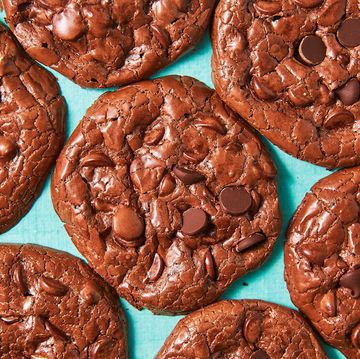If you haven't yet watched Chasing Happiness, the Jonas Brothers documentary that recently dropped on Amazon Prime, you have some homework to do. That is, if you're a rabid Jonas Brothers fan who can't get enough of Nick, Joe, and Kevin. If you're not, what are you doing here?! Anyway, whether you've already watched or not, we're here to bring attention to an important scene.
Long before the break-up(s), the brothers were just a couple of kids heading to shows in a van. This was pre-tour bus, guys. It was during this time that Nick was diagnosed with Type 1 diabetes. In the documentary, the Jonas family describes the worrisome symptoms that brought Nick to the hospital, from mood swings to extreme weight loss to a LOT of soda.
"Every time we would stop [on the road] Nick would get this massive Big Gulp," Kevin recalls in Chasing Happiness. He would drink massive amounts of water and soda which led to bathroom breaks "every 15 minutes," Joe says: "It was like a running joke."
While bandmates' complaints about Nick's increasing irritability were concerning, it was his weight that sounded the alarm. One time while changing for a show, Kevin remembers being able to see "every single bone in [Nick's] body." His parents took him to the pediatrician who immediately sent him to the hospital where he was officially diagnosed with diabetes.
That scene shows some of the very real symptoms for diabetes. Let's break down the rest.
What is diabetes?
In short, it's a disorder that occurs when your body can't properly handle insulin. In the case of Type 1 diabetes, "the body's immune system destroys, or attempts to destroy, the cells in the pancreas that produce insulin," Stanford Children's Health says. Type 1 diabetes accounts for five percent of all diagnosed cases of diabetes in the U.S. Type 2 diabetes occurs when the body can't produce enough insulin or can't properly use it.
What are the symptoms?
While they differ slightly by type, both include the following:
- Unusual thirst
- Frequent urination
- Weight loss and increase in appetite
- Blurred vision
- Nausea and vomiting
- Irritability and mood changes
- Yeast infection in girls (Type 1 symptom)
- Tingling or loss of feeling in the hands or feet (Type 2 symptom)
How is it treated?
Again, this differs by type. Per Stanford Children's, "Children with type 1 diabetes must have daily injections of insulin to keep the blood sugar level within normal ranges." Treatment can also include regular diet, exercise, and blood or urine tests, depending on what your doctor recommends.
In some cases, Type 2 diabetes can be controlled by losing weight, but in others medicine or insulin might be prescribed too.
What are the risks?
If untreated or mistreated, diabetes can lead to high blood sugar, low blood sugar, or diabetic coma. However, if managed regularly, people with diabetes can live as long as a person without the condition. In a post 13 years from the day he was diagnosed, Nick said this:
Prioritizing my physical health, working out and eating healthy and keeping my blood sugar in check. I have full control of my day to day life with this disease, and I’m so grateful to my family and loved ones who have helped me every step of the way. Never let anything hold you back from living your best life.













